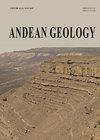北纬5-6°安第斯山脉北部上中新世拉斑玄武岩火山产物的成分和地质温度分析:Combia火山省
IF 1.2
4区 地球科学
Q3 GEOLOGY
引用次数: 0
摘要
Combia火山岩省(~11-5Ma)是一个火山碎屑岩序列,位于哥伦比亚西北部,位于北纬5-6°的中部和西部。其来源与纳斯卡板块在安第斯山脉北部南美洲板块下俯冲产生的岩浆弧的火山活动有关。该省矿床的分布、组成和年代地层学是众所周知的,火山序列的特征是组成双峰。较老的岩石(约11-9 Ma)显示出拉斑玄武岩的亲和力,而较年轻的岩石(大约9-5 Ma)大多为钙碱性,并识别出一些埃达克岩样特征。尽管钙碱性岩浆的岩浆系统先前已被广泛研究,但拉斑玄武岩岩浆在岩浆停滞和上升过程中发生的过程尚不清楚。这项工作通过对该省中部露头的拉斑玄武岩熔岩流的研究,通过岩石学、矿物化学、全岩分析和结晶条件的地热气象学计算,弥合了这一差距。从结构上讲,岩石为斑状,含有斜长石(An50-90)和斜辉石(辉石和辉长岩)斑晶和微斑晶,嵌入玻璃质和微晶基质中。岩石成分从玄武岩安山岩到安山岩不等(52.8-57.8 wt%SiO2),相对富集度为LILE到HFSE,REE到球粒陨石。根据几种斜长石熔体和辉石熔体地热温度计,斜长石的结晶条件估计为T=1095-1153°C,P=0.22-0.60 GPa,辉石的结晶条件为T=1046-1131°C,P=0.009-0.21 GPa,辉长岩的结晶条件估算为T=867-1039°C,P=0.40-0.60 GPa。这些结果表明,拉斑玄武岩产物的岩浆上升速度相对较快,并且主要通过分级结晶进行演化。LILE元素的富集,FeOt、TiO2和CaO相对于SiO2含量的负趋势,以及一些不平衡的结构,也是地壳污染和岩浆补给的证据。因此,有人提出,Combia火山区最初是一个简单的岩浆系统,拉斑玄武岩产物是由相对快速的岩浆上升产生的。然后,一个与长期岩浆停滞有关的更复杂的岩浆系统,允许熔体演化形成先前定义的钙碱性岩浆。本文章由计算机程序翻译,如有差异,请以英文原文为准。
Compositional and geothermobarometric analysis of the Upper Miocene tholeiitic volcanic products in the northern Andes at 5-6° N latitude: The Combia Volcanic Province
The Combia Volcanic Province (~11-5 Ma), is a volcaniclastic sequence located in northwest Colombia between the Central and Western cordilleras at 5-6° N latitude. Its source is associated with the volcanic activity of the magmatic arc produced by the subduction of the Nazca plate under the South American plate in the northern Andes. The distribution, composition, and chronostratigraphy of the province’s deposits are well-known, with the volcanic sequences characterized as compositionally bimodal. The older rocks (ca. 11-9 Ma) display tholeiitic affinity, whereas the younger (ca. 9-5 Ma) are mostly calc-alkaline, with some adakite-like signature recognized. While the magmatic system for the calc-alkaline magmas has been previously extensively studied, the processes that occurred during the magma stagnation and ascent are unknown for the tholeiitic magmas. This work bridges this gap by the study of tholeiitic lava flows outcropping at the center of the province, through petrography, mineral chemistry, whole-rock analysis, and geothermobarometry calculations of the crystallization conditions. Texturally, the rocks are porphyritic with plagioclase (An50-90) and clinopyroxene (augite and pigeonite) phenocrysts and microphenocrysts, embedded in a glassy and microcrystalline groundmass. Compositionally, the rocks vary from basaltic andesite to andesite (52.8-57.8 wt% SiO2), with relative enrichments of LILE to HFSE and REE to chondrite. Crystallization conditions, based on several plagioclase-melt and pyroxene-melt geothermobarometers, were estimated at T=1,095-1,153 °C and P=0.22-0.60 GPa for the plagioclase, T=1,046-1,131 °C and P=0.09-0.21 GPa for the augite, and T=867-1,039 °C and P=0.40-0.60 GPa for the pigeonite. These results suggest a relatively rapid magma ascent for the tholeiitic products as well as an evolution mostly through fractional crystallization. The LILE elements enrichment, the negative trend in the FeOt, TiO2 and CaO versus SiO2 content, together with some disequilibrium textures, are also evidence of crustal contamination and magma recharge. Thus it is proposed that the Combia Volcanic Province started as a simple magmatic system, where the tholeiitic products were generated by a relatively rapid magma ascent. Then, a more complex magmatic system linked to long-term magma stagnation, allowed melt evolution to form calc-alkaline magmas as previously defined.
求助全文
通过发布文献求助,成功后即可免费获取论文全文。
去求助
来源期刊

Andean Geology
地学-地质学
CiteScore
3.90
自引率
0.00%
发文量
17
审稿时长
>12 weeks
期刊介绍:
This journal publishes original and review articles on geology and related sciences, in Spanish or English, in three issues a year (January, May and September). Articles or notes on major topics of broad interest in Earth Sciences dealing with the geology of South and Central America and Antarctica, and particularly of the Andes, are welcomed.
The journal is interested in publishing thematic sets of papers and accepts articles dealing with systematic Paleontology only if their main focus is the chronostratigraphical, paleoecological and/or paleogeographical importance of the taxa described therein.
 求助内容:
求助内容: 应助结果提醒方式:
应助结果提醒方式:


